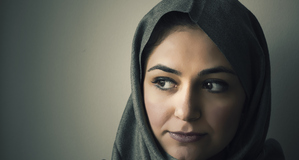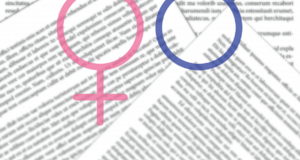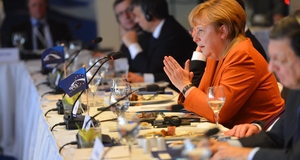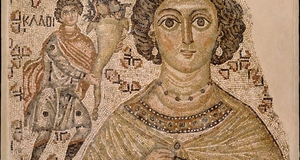Awareness of Emirati Women's Economic Roles Before the Oil Boom: Changing Perceptions of Gender Roles?
By
2016, Vol. 8 No. 10 | pg. 1/2 | » In the United Arab Emirates (UAE) and the Gulf Cooperation Council (GCC) states in general, women played an important economic role in the pre-oil era (before the 1960s) in addition to their “traditional” domestic role. Fatima Al-Sayegh states that women’s economic roles in the UAE were particularly significant between 1900 and 1930 (Al-Sayegh 2001). Today, however, the dominant perception of Arab Gulf women before the oil is relegated to the domestic sphere. The common belief is that it is only recently that Gulf women started playing economic and leadership roles. This perception is understandable, as the percentage of female labor participation in the GCC states has dramatically increased from 1% in 1975 to 17% percent in 2009 (Al Awad 2015; Metcalfe 2008). Notably, the government’s push for increased female participation in the labor force and in leadership positions is significant and appears more progressive than that of Gulf society at times. Indeed, Gulf society still views the male as the breadwinner of the family, even if women contribute significantly to the household (Metcalfe 2008). Government support for Emirati women has been immense in the last decade. In the last election in 2015, only one woman was elected by an electorate of approximately 200,000 Emiratis from the general population, but eight were appointed by the rulers (this was the case in the past election as well). A female president was also appointed by the UAE’s rulers in 2015 (Khoori 2015; Khoori and Dajani 2015). In 2016, five women were appointed as Ministers or Ministers of State (The National 2016). However, employment rates for women continue to be relatively low in GCC states (Al Awad 2015). While there are more and more women holding leadership positions, there are still mixed reactions towards them within Emirati society, and conservative segments in society still promote the importance of maintaining “tradition.” Ironically, although women did play an important economic role pre-oil, there is still a false portrayal of a woman’s “traditional” role as confined to the domestic sphere. In light of the descriptions of Emirati females’ roles in the economy pre-oil which will be discussed below, this paper investigates the extent to which young Emirati females are aware of women’s economic roles in the pre-oil Emirates and explores possible implications for an increased awareness of this topic.Social Dominance TheoryAccording to Sidanius and Pratto’s social dominance theory (SDT) (1999), behavioral asymmetry occurs when deprecated groups participate in their own subordination, stating that subordinate groups, either actively or passively, maintain social hierarchies (43-44). These hierarchies are reinforced through legitimizing myths, wherein subordinate groups in society endorse their own oppression. This is seen in the responses of Blacks and women in the US. Although Black people in the US objectively have less favorable opportunities than Whites in the job market, education and housing, it was not only Whites who were unaware of this type of discrimination. Indeed, Black respondents also had similar attitudes, generally believing they have the same opportunities as Whites (106). Similarly, they found that women had similar perceptions on gender as men did, endorsing as much sexist stereotypes about themselves as men did (111). As SDT and legitimizing myths showcase, it is not uncommon for women to legitimize and endorse sexism and traditional gender roles of a patriarchal society (Becker 2010; Becker and Wagner 2009; Kilianski and Rudman 1998). Research in Germany found that women in general validate sexism and promote the gender bias that exists today, endorsing both benevolent and hostile sexism. Benevolent sexism can be explained in the endorsement of traditional gender roles, such as an idea that women need to be protected by men. Remarkably, women also endorsed hostile sexism, which views women even more negatively (Glick and Fiske 2001; Becker 2010, 453-454). Examples of hostile sexism include statements such as: “When women lose to men in fair competition, they typically complain about being discriminated against,” or “women are seeking for women to have more power than men” (Becker 2010). Female respondents specifically endorsed hostile sexism when they imagined it directed towards feminists or career-women (who are considered to be norm-deviating). Similar research results were echoed in other studies. Garcia-Retamero and López-Zafra (2006) found that Spanish women and elder respondents expected women to perform lower than men in male-dominated industries or unspecified industries. Men are never expected to fare worse than women, even in a female-dominated industry. External attributes (such as a need for expanding the industry) were ascribed to a female’s success in unspecified industries or male-dominated industries, while males were expected to succeed regardless of industry, with the attribution of internal factors (such as the capacity of the candidate) for their success (Garcia-Retamero and López-Zafra, 2006). Therefore, even if laws and regulations allow women to have more freedom in different areas of their lives, society still maintains patriarchal perceptions. Historical BackgroundEmirati Women's Economic Roles Pre-Oil: 1900 through 1960sThe fact that women played “traditional” roles as mothers and wives in Gulf society before the advent of the oil industry is a well-known aspect of pre-oil society. While women had less freedom in many social aspects of life, they were not particularly relegated to the private and domestic sphere, as is commonly described today. Women were significant contributors to the economy before the discovery of oil (El Saadi 2012; Al-Sayegh 2001; Lootah et al. 1993, 48). In these pre-oil times, women contributed to the economy and political life through various means: Women from the royal family, such as Sheikha Hussa Al-Murr, the wife of Dubai’s late ruler, Sheikh Saeed, rallied her armed forces and defended Dubai's tower when it was under attack (Al-Sayegh 2001; Pinto 2012, 24). Sheikha Salama bin Butti al-Qubaisi, Sheikh Zayed's mother, helped Sheikh Zayed financially when he did not have enough funds to sustain Al Ain’s economy before the oil (Maitra 2007, 50). While women’s involvement in politics was still not very common, women from other walks of life were involved in the public sphere through different economic activities. Ordinary women were even more exposed to everyday public interactions than women from royal families or upper-social class women, as they faced less social restrictions. Lower-middle class women ran their own shops, while upper-middle class women were merchants, some of them owning pearling and shipping boats (Al-Sayegh, 2001; Soffan, 1980, 68). Accounts differ on whether these female merchants traded and dealt with men directly (Al-Sayegh 2001) or if they conducted their business through male relatives (Soffan 1980, 68). Other women used to sell and buy publicly in the market, or by selling door-to-door. Some worked in agriculture, midwifery, knitting, weaving, harvesting the land and selling dairy products, among other jobs (El Saadi 2012; Al-Sayegh 2001; Lootah et al. 1993, 49). Some women worked in folk medicine, which included using both herbal medicine and surgical procedures, such as cauterization and cupping. They treated both men and women and were respected throughout the Arab Gulf states. One prominent example is Hamama Al-Tiniji in Sharjah, who supported herself and her family through her work (El Saadi 2012, 160). Women’s public participation in the fish market was also significant. When the legislative council in Dubai tried to impose a ban on women selling fish in the market, the fishermen protested, as their wives managed to sell the fish for higher prices than they did (Al-Sayegh 2001). Today, selling in places such as the fish market is considered shameful by some. Not only is it negatively seen as a form of lower-social class work, but it also involves being heavily exposed to the public and to men. The belief that women should not be exposed to men is prevalent in society, and public schools and public universities remain gender-segregated. This is so much the case that public universities have high security ensuring that male students do not enter the campus when females are around, and in some universities, that the female’s guardian is notified every time the student enters and leaves campus (Bristol-Rhys 2008, p. 102). Therefore, while the increase in female leadership signifies a higher voice and presence in the public sphere, social structures restrict women’s place to the private sphere, where some segments of society believe she belongs. The Deterioration of Women's Economic Roles Pre-OilAlthough women’s occupations described above were prevalent throughout the pre-oil era, women’s economic roles were mostly prominent before the collapse of the pearl market in the 1930s. Al-Sayegh (2001) states that after economic situations worsened, women’s economic roles went into decline. Health conditions also deteriorated, and many more women died during childbirth. Progress in terms of health and education only started appearing in the 1950s with the establishment of health and educational institutions, and it was then that female participation in the workforce started increasing again year-by-year. However, this was not necessarily viewed favorably, and the growing social attitude during this stage of development was fear over the social impact of female employment on the family (Al-Sayegh 2001). After the discovery of oil in the 1960s and after the formation of the union of the seven emirates of what now constitutes the UAE, the rulers of the nation strongly pushed for women to receive a formal education and join the workforce. From their side there was a full understanding of the dire need for women to build the young nation. UAE University was formed a few years after the union of the seven Emirates, ensuring cultural considerations (such as gender segregation) was in place to accommodate more women (Kemp 2013). Although the new oil economy offered women more educational and economic opportunities, the educational opportunities were much more highly utilized by Emirati females than employment ones (Kemp and Zhao 2016, 989). While education was seen as useful for a woman not only outside of work but also inside the home (for example, with the assumption that a more educated mother can raise her children in a better way), joining the workforce did not have such positive implications. Indeed, there was no more financial need for many women to work, and spending time outside the house and away from family and children was seen as a distraction from her home life. Therefore, although Emirati women had more opportunities to work, many continued to stay at home, similarly to those women before them who found no employment opportunities when they needed ones. Today, the “traditional” Emirati woman is associated with this woman, the one who’s space is solely in the domestic sphere. The sections below detail these findings. Research MethodologyThis case study research took place in Zayed University, a national university of the UAE, which has campuses in both Dubai and Abu Dhabi. Zayed University has around 10,000 female students in both campuses, mostly studying for their undergraduate degrees, with some of the students working towards their master’s degree. Students come from all the seven Emirates, with students from Sharjah, Ajman and the Northern Emirates studying in Dubai. However, most students at Zayed University are from Abu Dhabi and Dubai. Student age is normally between 17-25, although there are older students working on their master’s degrees or older students who came back to school. Almost all students at Zayed University are Emirati. A survey with twenty-three questions was sent out by email to students via the campus announcement system, which reaches all students, and only female Emirati students were requested to take it. The survey included questions on knowledge of female economic and leadership roles. An example of a knowledge question is “women played important economic roles before the oil.” The desired sample was 355 respondents with the confidence level of 5 percent and confidence interval set at 95 percent (we received 351 student responses). Over the course of two semesters, Fall 2015 and Spring 2016, a quasi-experiment was conducted with 76 students. The quasi-experiment consisted of fifteen-minute lectures about women’s economic role before the oil in five different classes. This experiment was conducted to better understand students’ awareness of women’s economic roles before the oil by engaging with them directly. The experiment was conducted in five different classes, two of them consisting mostly of second year students and three of them mostly of first-year students. The quasi-experiment was conducted in classes where the courses are mandatory and all students have to take them, therefore the quasi-experiment was not conducted in courses that were major-specific. Throughout the findings section, I have used some of my own observations as an instructor of Emirati females in a national university, as well as my own experience as an Emirati female living in Emirati society, to support my analysis. This includes not only my daily experiences and classroom experiences, but also the material that I use to teach in class, or other material that I have consulted while teaching. These materials have been significant to understanding the messages that students receive about women’s “traditional” roles in the UAE. I consider this anecdotal evidence significant for analyzing my findings in a more nuanced manner. Results and AnalysisThe survey tests students’ knowledge and perceptions about Emirati female leadership. To examine students’ knowledge about women’s economic role before the oil, the statements in the survey read: “Emirati women played an important economic role before the oil,” and “Emirati women played an important leadership role before the oil.” Students respond to these questions through a range of five options from “strongly agree” to ‘strongly disagree.” The findings are detailed below:
Although the results show more that 50% of the respondents were aware of women’s economic and leadership roles before the oil, it is possible that these results do not reflect students’ awareness or understanding of women’s economic roles in the pre-oil Emirates. Indeed, it is possible that “agree” and “strongly agree” responses were due to an assumption that the more “positive” option is the “correct” answer. The reason this appears to be a plausible explanation is because I have witnessed contrary results in the four semesters that I have taught an Emirati Studies course (where we discuss women’s economic roles pre-oil) and in the quasi-experiments I conducted. Students always associated the pre-oil, “traditional” woman with the domestic sphere, rarely, if ever, mentioning her economic role. This does not necessarily mean that students are not at all aware that women played some sorts of economic roles before the oil. Rather, it may indicate that their awareness of women’s pre-oil economic roles is not as significant as their awareness of her domestic role. Indeed, they have likely heard, read and seen much more about women’s domestic roles than about their economic roles. The following scenarios are typical of the discussion that occurred during the regular classroom time and during the quasi-experiments. Before beginning the lecture regarding women’s economic roles in the pre-oil era, I asked students regarding what they know about women’s roles during that period. All students who answered mentioned women’s domestic roles but not their economic roles: “Cooking,” “cleaning,” “taking care of children,” and “staying at home” were the common answers. Some specifically said that women did not work in the pre-oil era. However, once the lecture began and women’s economic roles before the oil were explained, it became clear that some students had prior knowledge of some of these roles but that this knowledge was not enough to create a representation of a “working woman,” or a woman whose role was outside the domestic sphere. Some information was new to the students, such as women owning boats or being merchants. However, when mentioning occupations such the selling of fish in the market by women pre-oil, it was clear that this was well known by the students, which is not surprising as this is relatively well-known within society as well. Therefore, although some knowledge about women’s economic roles before the oil did exist, this knowledge is not promoted or disseminated in the same manner as a woman’s domestic role is, and thus does not translate into a deeply held belief of what women’s roles in society were. Although the modern Emirati woman is portrayed as a worker as well as a mother, the pre-oil woman is commonly portrayed as one who is in charge of domestic work only. This may be due both to the effects of the modernization process of the UAE and its formal social reproductions. In terms of the former, since the 1970s until relatively recently, the oil wealth has allowed Emiratis to be financially stable without the need for the mother to contribute to the family’s income. Indeed, female participation in the workplace during the 1970s was extremely low at 1% (Al Awad 2015). While women in the pre-oil era needed to work, many women in the 1970s could afford to stay at home, and indeed, many did. Although women started joining the workforce in increasing rates recently, this is a recent development since the independence of the nation in 1971 (Al Awad 2015). Since women were not part of the workforce for many decades beginning from the nation’s birth, as well as for some time before it (although that was due to economic stagnation), this helped in shaping perceptions of the “traditional” Emirati woman who stayed at home and was responsible for the domestic sphere. Although the “traditional” woman that Al-Sayegh and others discussed (cited in the literature review) also played an economic role, the stay-at-home mother of the 1970s is the one that is imagined when referring to “traditional” women today, even when denoting women of the pre-oil era. Formalized social reproductions have reinforced this image, especially school and even university textbooks. The Emirati Studies book I teach at the university level makes absolutely no mention of women’s economic roles pre-oil in the chapter that discusses men’s and women’s roles in the UAE before and after the oil (Ministry of Higher Education UAE 2015). In fact, it stresses the patriarchal stresses within Emirati society pre-oil, depicting women to have only left their houses to work after the modernization of the country. As I have been teaching this course for two years, I have often consulted social studies textbooks at the high school level to get an idea of what students have already learnt in high school and what they need further training in. An observation of 2015 versions of these high school textbooks allowed for a greater understanding of how women’s economic roles pre-oil are described. While textbooks did at times depict contemporary women working in “male-dominated” jobs, there was rarely any mention of women’s economic roles before the oil, and women pre-oil were mostly presented as housewives or workers of the domestic sphere. It appeared as though the men, such as the pearl-divers, were the only economic sustainers of the family (Ministry of Education UAE 2015). These textbooks are government produced and taught in all public schools and most private schools, reaching many students. The effects of textbooks have been proven to have profound effects on perceptions of gender and gender roles.1 Therefore, it is likely that beliefs, supported by formal social reproductions about women’s roles in the pre-oil era, have affected students’ perceptions of women’s “traditional” roles in the UAE. It is possible that these representations that students are commonly in contact with have come to serve as legitimizing myths. The “traditional” woman is always portrayed as a “domestic” woman, and that becomes the image that society, and women, accept. Indeed, although students have knowledge about women’s roles before the oil, these are not deeply entrenched beliefs of what women’s roles really were. Going back to SDT and legitimizing myths (Sidanius and Pratto, 1999), it seems that the myth of the “domestic woman” left a stronger impact than the fact that women had both a domestic and economic role.Continued on Next Page » Suggested Reading from Inquiries Journal
Inquiries Journal provides undergraduate and graduate students around the world a platform for the wide dissemination of academic work over a range of core disciplines. Representing the work of students from hundreds of institutions around the globe, Inquiries Journal's large database of academic articles is completely free. Learn more | Blog | Submit Latest in Women's & Gender Studies |


















